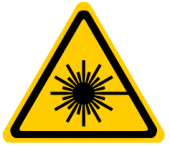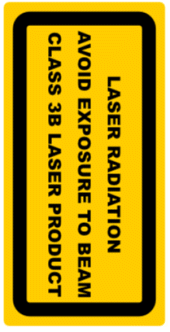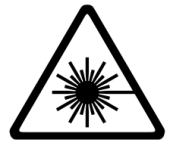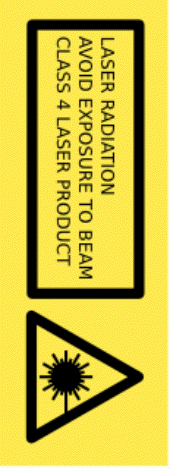Laser Safety in Night Clubs and Events.
Sound
Lasers
Video.
Tech Tips






Laser Safety, for NightClubs and other Events
It is a common misconception that as lasers became smaller they became safer. Well it sort of makes sense. Club lasers used to be huge water or forced air for cooling, and now they are small low power devices. Our first gas filled argon ion laser consumed 3,000 watts and gave out 0.030 watts or 30 milliwatts. My latest design laser projector consumes less than 250 watts and has 600milliwatts laser output power. That is over half a watt; 33 times more powerful and an eighth of the size! These laser powers are dangerous, they can blind. A laser power above half a watt can burn skin or cause fires.
These lasers can on no account be left running unattended and at all times must be under the control of a fully trained operator. The operator must be aware of the safety regulations, and have a site diagram showing the danger areas and laser powers.
Any laser left unattended must not point the beam anywhere within 6 metres of where the audience may be able to reach, and at any point it can not be above 5 milli watt.
This in theory means that the majority of the low cost automatic laser displays found in small clubs and pubs are illegal and unsafe. In general they don't come with any safety instructions. In many cases they also lack the warning markers required by law to be on all laser systems. At present the regulations are not known about by club owners, who are unaware of the dangers.
The low level of use of these lasers made it a low statistical danger. This however is changing as more imports of unregulated and hazardous products flow into the UK. Laser safety is not going to be regarded as a minor health and safety problem once these dangerous products are widely used.
Lasers and the Law
As ignorance is no excuse in law, obtain "Guidance Note PM19" Use of Laser for Display Purposes, from the Health and Safety Executive. BS EN 60825 should also be obtained as this give the maximum permissible safety levels. Read these leaflets, then you at least know what regulations you may or may not be breaking.
Health and Safety Regulations 2010
At least make sure that whoever is operating the laser has read the regulations.
Position the laser so no one can stare into the beam. Fire the laser above people's heads. The laser beam should be a minimum of 3 metres above head height for a laser under operator control. In many clubs and pubs this is impossible, almost any laser show involves scanning the audience. This is a very unsafe practice and it can only be done through smoke. The beam must not exceed the time/power curves that determine how much power will damage the eye. This depends upon the power of the laser, the scan size and the display frequency. The smoke density cuts the light from the laser and makes the audience scans look amazing; everyone likes to put their hands into the shimmering light as the particles scatter and reflect the beam. Scanning below the raised hands run the risk that the audience may be able to view the laser beam directly. This can cause permanent eye damage.
The amount of light received by the eye depends upon pupil size, and it is the eye's natural blink response that can help stop damage. It must be remembered that the audience at some events may be under the influence of either alcohol and or drugs. Alcohol slows down the blink response, and drugs tend to enlarge the pupils and thus increase the amount of light entering the eye. A drunk on ecstasy will be five times more liable to eye damage when compared to being sober.
To reduce this risk, professional lasers that meet British safety regulations have the ability to limit the laser output power to certain areas of the laser display. The power output for the areas will be heavily reduced for these designated display areas and smoke should be used. This does not guarantee that the laser display will be safe but it will greatly reduce the danger. Sometimes in a venue the air extraction system turns on and sucks all the smoke from the venue. The Laser Operator should monitor the display area and change the display accordingly with smoke density. A good display will not strain the eyes and will use the right amount of smoke for the best effect and safety. If the beam flashes across your eye and produces an afterimage that affects your vision then it is stopping you from seeing the laser show at its best and it is too powerful for safety. Good Laser Safety makes for a good laser show.
If it is Your Club
If it is your club, you are responsible for the laser installation and safety and the preparation of a display area safety diagram marked with hazard areas with their respective beam-power limits. You will also be required to list all safety factors of your equipment and explanation of all calculations. The supplier of your laser will supply this for you when he installs the laser. If the position of the laser is moved, or customer access changed, then the process must be redone with new safety laser powers calculated.
It must be mentioned that English Health and Safety regulations regard audience scanning as unsafe at any level above 5 milliwatt. British regulations on laser safety are much stricter than in the US and other countries. You should also warn customers when entering the display area with a sign stating the class of laser being used and to avoid exposure to the beam.
Laser Hire Safety
If you are hiring a laser it is your responsibility to ensure that laser safety regulations are followed. It is the responsibility of the persons doing the laser show to provide you with certification showing that the laser meets the safety requirements with diagrams showing display areas. Full information on safety zones and how they are calculated with documentation and diagrams must be provided. It is your responsibility to make sure that this has been done and have this information available for inspection.
Safer Laser Displays
To ensure the minimum risk of eye damage, the laser projector used must be fitted with a key that must be inserted and operated before the lasers will power up. If the laser is going to scan the audience then it is vital that the laser projector be fitted with a method of reducing beam power. It must be pointed out that scanning across the audience is never a completely safe practice, but it must never be done on full power. The full beam power from a class 4 laser must not even contact skin or any flammable material. Even looking at the laser's reflection of the laser beam from a white wall could be hazardous.
All display lasers should be fitted with a method to stop the laser output if there is a scanner failure. The laser should also be built in such a way that if a scan mirror falls off, the laser beam will not exit the case. All laser displays must be manned by an operator familiar with the laser and the controlling mechanisms or software, as well as the current safety regulations. The operator must be in command of the laser and display all the time that the laser is powered up. The operator must power down the laser and remove the key if the display is to be left unattended. This includes toilet and smoke breaks. If the laser is powered up then it must be under operator control. The operator must also be free from intoxicants during the performance. The operator is subject to the same drug and alcohol regulation levels as apply to operating a forklift or driving a car.
Display Laser Safety, Eye Damage
The beam from a display laser is capable of being focused by the eye to a fine point on the retina. This happens at all points on the retina and is capable of producing eye damage. This means that if the laser beam enters the eye from any direction then it will be focused to a point, and will be capable of producing eye damage. This eye damage will be noticed if it is from looking at the beam from the front. Furthermore it will appear brighter so the eye will blink to try to protect itself from damage. The person who has such eye damage will notice something is wrong, and get his eyes tested.
However, there are areas on the eye that detect movement. These movement detectors are in the peripheral vision. These are the cells that alert you that something is moving behind you, causing you to look around. You will not notice that these are damaged until you have a near miss with the car or bike overtaking you.
There is some suggestion that exposure to laser beams from display lasers, even at low power can cause long term eye damage. The laser must have the relevant safety signs on the laser. Stating class of laser and laser power. There must also be a sign adjacent to the source of laser output, warning of a laser aperture. Laser warning signs should also be shown at the entrance to the display area.
Check with the Health and Safety Executive for current regulations and with your local authority for their regulations. If it is an outdoor display you may need to inform and get permission for the display. This would have to be done with the authorities that are responsible for air-traffic and aviation in the area of the display.
Health and Saftey Regulations 2010
Downloadable as a PDF from their website.
Or the wikipedia Laser safety documents.
Laser Safety
